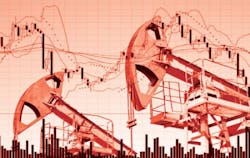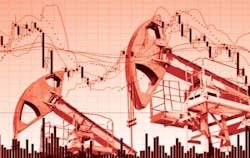The future of supply trading in the oil and gas industry
Jonathan Dison, Bender Consulting, Austin
The last two years have been a very interesting time for nearly every company in every industry – and not just in the US. The economic crisis impacted organizations worldwide. For most, cutbacks were the order of the day and self-preservation was key. But we are starting to emerge from the frozen wasteland of economic despair as the financial chill that slowed our global economy begins to thaw and business begins to stabilize.
Companies are cash rich and looking to take advantage of unique opportunities to return to profitability and gain a competitive edge that might not have been considered even two years ago. In the US alone companies are sitting on nearly one trillion in cash – the highest amounts ever in this country. Oil and gas companies are no different – cash rich in a recovering economy that is replete with opportunity. But where to begin?
Most oil and gas companies tend to focus on one area of the market. Upstream companies focus on the exploration and production side of the business, searching for oil and gas deposits and reserves to exploit. Downstream companies refine the crude product and deliver supply to end-users. Some span both the upstream and downstream markets.
Acquisition of depressed assets or strategic assets will certainly play a big role for many oil and gas companies, but this is somewhat of a sideways move that simply extends a company's reach within an area in which they already play. So what opportunities exist to expand beyond established business practices in the upstream and downstream markets?
Supply trading: an untapped resource for the bottom line
Supply trading represents both a huge opportunity and a huge challenge for oil and gas companies going forward, and is the area of expansion that takes oil and gas companies beyond simply playing in the upstream or downstream market. Many companies in the sector have a rudimentary play in trading, but nowhere near as sophisticated as many of the investment banks.
The reality is that supply trading, in the long run, will add tremendous value to the bottom line and provide much-needed insight into the full spectrum of exploration to distribution that many oil and gas companies don't have today. As mentioned earlier, oil and gas companies are looking to leverage their cash-rich positions to improve the bottom line as well as further optimize the full value chain.
Technology is playing a key role in facilitating this transition as well. Improvements in technology enable better data mining and decision-making support that will pay dividends in the long run.
So, what are the challenges and opportunities that exist? We'll explore both below in more detail:
Challenges
- The C-suite: Most executives in the oil and gas industry have risen through the engineering ranks to achieve their current positions. Most have a very clear understanding of the engineering challenges that exist in both the upstream and downstream worlds. But the world of supply trading is very foreign to many of them. The pendulum has also swung against risk. A conservative financial and business approach are the rule of the day. Memories of Enron and others are still very fresh in the energy industry, and the idea of supply trading is viewed with some degree of skepticism (or at least without a full understanding) at the highest ranks. Many are unwilling to risk their career for a concept that some believe will not provide a solid ROI. Without support from the top, most projects are doomed to failure.
- Trading systems: The trading technology is improving significantly. For the most part, the technology is sound and the concepts are good, but the implementation is poor. To put this in perspective, most Enterprise Resource Planning (ERP) systems achieve about 10% – 20% of value due to poor implementation because the focus has been primarily on technology and not on usability.
- Policy: The lack of a clear energy policy is causing problems across the industry as a whole, and certainly has an impact on supply trading as well. Without a clear understanding of the playing field, most companies are taking a conservative approach to any investments due to the extreme layer of complexity that is introduced.
Opportunities
- Shareholder value: The oil and gas companies who fully understand the implementation of trading systems stand to capture hundreds of millions in shareholder value, as well as offset and manage risk in the millions if not billions of dollars.
- Policy: Policymakers can control the degree of speculative trading by controlling the banks' role in commodity trading. The investment banks' role in the crude and commodities market will likely be limited to ensure a decrease in volatility in the market. When this happens, it will result in less competition from the investment bankers for the oil and gas companies and make it easier for homeowners and businesses to accurately forecast budget.
- Knowledge of the full value chain: By investing in a trading strategy, oil and gas companies will be given the opportunity to see the full value chain. Most companies know how to pull oil out of the ground, refine it and sell it. But tremendous value exists in understanding the entire marketplace to gain critical knowledge that can be exploited to know what levers to pull and when. For example, what move do oil and gas companies need to make if a ship goes down carrying 1 million barrels of crude? Having insight into the full value chain makes for smarter upstream and downstream bets, and will influence upstream and downstream capital investments.
Predictions
- Policy: If crude prices hover above $90 a barrel, expect to see increased efforts by lawmakers to keep crude prices down. Efforts will include decreasing speculative trading by investment bankers to reduce volatility as well as increasing production by easing the deepwater moratorium.
- Technology: Trading and risk management systems will consolidate over the next five years, resulting in winners and losers.
- ERP Systems: There will be an increased investment by ERP companies to reduce integration complexity for supply and trading systems.
- Executives: This generation and the next generation of C-suite executives will exhibit a greater appetite for risk than their predecessors to go after value capture. They will trust systems, policies and process to get the picture they need to make informed decisions.
- Chevron, Exxon: Chevron and Exxon will leverage their upscale/downscale reach to move up the trading scale in a positive way.
Supply trading is extremely complex, but oil and gas companies need this as a foundational element because they need to better understand their risks so they can properly hedge. The challenge is that the systems are still immature; but they will continue to improve. The companies that will see the most success in the short term – and position themselves well for the long term – are the ones that invest in high-quality implementation, integration, adoption and training to begin to see value opportunities across the entire chain. It's going be a bumpy, bumpy ride, but well worth it to the oil and gas companies that implement a solid trading strategy. OGFJ
About the author
More Oil & Gas Financial Journal Current Issue Articles
More Oil & Gas Financial Journal Archives Issue Articles
View Oil and Gas Articles on PennEnergy.com


